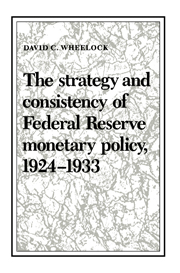Crossref Citations
This Book has been
cited by the following publications. This list is generated based on data provided by Crossref.
Schweikart, Larry
1991.
U.S. Commercial Banking: A Historiographical Survey.
Business History Review,
Vol. 65,
Issue. 3,
p.
606.
Havrilesky, Thomas
1993.
The Pressures on American Monetary Policy.
p.
81.
Cassis, Y.
and
Cottrell, P. L.
1994.
Financial History.
Financial History Review,
Vol. 1,
Issue. 1,
p.
5.
Havrilesky, Thomas
1995.
The Pressures on American Monetary Policy.
p.
83.
Wheelock, David C.
1996.
Stability in the Financial System.
p.
26.
Tabarrok, Alexander
1998.
The separation of commercial and investment banking: The morgans vs. The rockefellers.
The Quarterly Journal of Austrian Economics,
Vol. 1,
Issue. 1,
p.
1.
Troesken, Werner
1998.
Postwar economic stabilization: A stylized half‐truth.
Critical Review,
Vol. 12,
Issue. 1-2,
p.
77.
Humphrey, Thomas M.
2000.
Monetary Policy Frameworks and Indicators for the Federal Reserve in the 1920s.
SSRN Electronic Journal,
Ritschl, Albrecht
and
Woitek, Ulrich
2000.
Did Monetary Forces Cause the Great Depression? A Bayesian VAR Analysis for the U.S. Economy.
SSRN Electronic Journal,
Stauffer, Robert F.
2000.
Back to Basics: Reserve Requirements and Money Stock Changes, 1929–1936.
The American Economist,
Vol. 44,
Issue. 1,
p.
62.
Humphrey, Thomas M.
2001.
Quantity Theory and Needs-of-Trade Measurements and Indicators for Monetary Policymakers in the 1920s.
History of Political Economy,
Vol. 33,
Issue. Suppl_1,
p.
162.
2002.
World Economic Outlook, April 2002: Recessions and Recoveries.
Bordo, Michael D
2003.
Market Discipline in Banking: Theory and Evidence.
Vol. 15,
Issue. ,
p.
157.
Balderston, Theo
2003.
The World Economy and National Economies in the Interwar Slump.
p.
1.
Bullard, James
and
Cho, In-Koo
2003.
Escapist Policy Rules.
SSRN Electronic Journal,
Bordo, Michael D.
and
Wheelock, David C.
2006.
When Do Stock Market Booms Occur? The Macroeconomic and Policy Environments of 20th Century Booms.
SSRN Electronic Journal,
Siklos, Pierre L.
2007.
The Fed's Reaction to the Stock Market During the Great Depression: Fact or Artefact?.
SSRN Electronic Journal,
Bordo, Michael D.
Dueker, Michael
and
Wheelock, David C.
2007.
Monetary Policy and Stock Market Booms and Busts in the 20th Century.
SSRN Electronic Journal,
WHITE, LAWRENCE H.
2008.
Did Hayek and Robbins Deepen the Great Depression?.
Journal of Money, Credit and Banking,
Vol. 40,
Issue. 4,
p.
751.
Huston, John H.
and
Spencer, Roger W.
2009.
Speculative excess and the Federal Reserve's response.
Studies in Economics and Finance,
Vol. 26,
Issue. 1,
p.
46.





